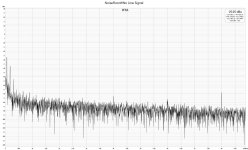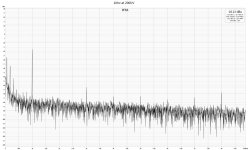Was testing the input/output with TotalMix and was surprised at this high level. Started input out at 20uv and had to raise it to 200 mV to get the output to around -20dB.
Regardless, the tests were for noise and the news there is splendid. No harmonic distortion results were reported but the ones generated were very, very low.
Regardless, the tests were for noise and the news there is splendid. No harmonic distortion results were reported but the ones generated were very, very low.
@PierreQuiRoule and @Peppe : Thanks for the information.
Redid the tests on the other channel and it turns out the first ones were done on a blown channel -- had been doing earlier tests and, apparently, something took that first channel out.
Here are the Noise and 1Khz results for a working channel at 200uV. Obviously, these are completely different and much closer to what I originally thought the noise figure would be -- around -80dB. The system noise figure continues to be the much different -135dB.
The good news is that the 1KHz test tone is much better mannered with far less harmonic ringing.
SO SORRY about the confusion above.
Redid the tests on the other channel and it turns out the first ones were done on a blown channel -- had been doing earlier tests and, apparently, something took that first channel out.
Here are the Noise and 1Khz results for a working channel at 200uV. Obviously, these are completely different and much closer to what I originally thought the noise figure would be -- around -80dB. The system noise figure continues to be the much different -135dB.
The good news is that the 1KHz test tone is much better mannered with far less harmonic ringing.
SO SORRY about the confusion above.
Attachments
There appear to be higher levels of noise below 500Hz. If the horizontal axis is set to a logarithmic scale, information with respect to the frequencies of this noise would be easier to see.
Rising noise at lower frequency is normal (RIAA curve). Harmonic levels are still way off. Cf. measurements at Post #3166. Note that REW can show noise level: check the distortion display box.
Suggestions if I may: Make sure REW is configured properly (24 or 32 bit words, not 16 bit, and sample rate in sync with digital card, etc). This can be finicky. Displaying dBFS versus log frequency would make it easier for you to compare against others’ measurements. Don’t give up.
Suggestions if I may: Make sure REW is configured properly (24 or 32 bit words, not 16 bit, and sample rate in sync with digital card, etc). This can be finicky. Displaying dBFS versus log frequency would make it easier for you to compare against others’ measurements. Don’t give up.
Hello,
It is not a real value of noise we see at the "noise floor" of the FFT.
The FFT "noise floor" that we see in the FFT depends on the sample size and the number of averages. The windowing that the FFT math uses is much closer to a accurate value at the FFT peaks.
For the noise floor measure to be in the ballpark you need to use the root Hz math and scale.
Like in the Bugle FFT below.
This Pre Pre-Amp has 36db gain

This is my Pearl 3 with 50.4db Gain on the low setting.

It is not a real value of noise we see at the "noise floor" of the FFT.
The FFT "noise floor" that we see in the FFT depends on the sample size and the number of averages. The windowing that the FFT math uses is much closer to a accurate value at the FFT peaks.
For the noise floor measure to be in the ballpark you need to use the root Hz math and scale.
Like in the Bugle FFT below.
This Pre Pre-Amp has 36db gain
This is my Pearl 3 with 50.4db Gain on the low setting.
I did a thing!
I don't have a turntable any longer, but my brother still loves to spin vinyl. I'm not sure what gave me more pleasure, the build or learning more about turntables. Absolutely fascinating. Every TT I had in the past was simply set up by the "guy at the store". I never knew anything about RIAA / cartridge loading etc., and I still don't know much. I had to look up my brother's cartridge to set this up for him. Hopefully I got it correct.
It's an Ortofon Blue - Best indications are that 47k and 220pF is the best bet. Any advice is appreciated. I will triple check with him b/c I am not sure if it is a "2M" Blue or not. I got it for him as a gift sight unseen years ago.
https://ortofon.com/products/2m-blue#specifications
It's going in the carry-on today for a trip to the Carolinas.
A HUGE thank you to @wayne for creating amazing projects for DIYers, and to @6L6 and @rhthatcher for the expertly curated kits and amazing build documentation.
Some pics for fun. Off to the airport.
Enjoy!
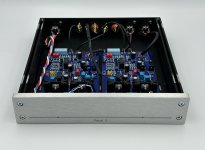
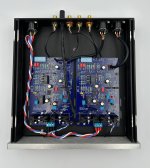
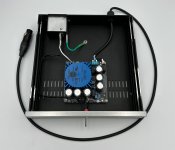
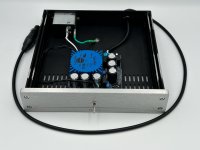
I don't have a turntable any longer, but my brother still loves to spin vinyl. I'm not sure what gave me more pleasure, the build or learning more about turntables. Absolutely fascinating. Every TT I had in the past was simply set up by the "guy at the store". I never knew anything about RIAA / cartridge loading etc., and I still don't know much. I had to look up my brother's cartridge to set this up for him. Hopefully I got it correct.
It's an Ortofon Blue - Best indications are that 47k and 220pF is the best bet. Any advice is appreciated. I will triple check with him b/c I am not sure if it is a "2M" Blue or not. I got it for him as a gift sight unseen years ago.
https://ortofon.com/products/2m-blue#specifications
It's going in the carry-on today for a trip to the Carolinas.
A HUGE thank you to @wayne for creating amazing projects for DIYers, and to @6L6 and @rhthatcher for the expertly curated kits and amazing build documentation.
Some pics for fun. Off to the airport.
Enjoy!




Great journey!
Advice?
Ok, when you see a cartridge load, it is what the cartridge "sees". That means the load on the RIAA preamp plus cable.
In your MM case, you can neglect the resistance of the cable (very small, few milli Ohm vs the preamp loading of 47kilo Ohm), but you can't do so with the cable capacitance.
It is difficult to know the capacitance of your cable between cartridge and RIAA preamp. Either you know that value, or you can guesstimate that if the TT is not too old and all cables came with it it is probably around 100pF if not a bit more.
All that to say that you should probably select a 100pF loading on your RIAA preamp to get you to the required 220pF.
I hope this helps
Claude
Advice?
Ok, when you see a cartridge load, it is what the cartridge "sees". That means the load on the RIAA preamp plus cable.
In your MM case, you can neglect the resistance of the cable (very small, few milli Ohm vs the preamp loading of 47kilo Ohm), but you can't do so with the cable capacitance.
It is difficult to know the capacitance of your cable between cartridge and RIAA preamp. Either you know that value, or you can guesstimate that if the TT is not too old and all cables came with it it is probably around 100pF if not a bit more.
All that to say that you should probably select a 100pF loading on your RIAA preamp to get you to the required 220pF.
I hope this helps
Claude
Mystery finally solved!
I recently had the chance to put a known-good phono amp into my system, and had the exact same distortion. It turned out to be my preamp distorting, not the Pearl causing the issue.
I put a pot in between the Pearl and my preamp, and all is well. The Pearl sounds great!
Thanks to everyone who gave me guidance on the issues I caused earlier in the process.
I recently had the chance to put a known-good phono amp into my system, and had the exact same distortion. It turned out to be my preamp distorting, not the Pearl causing the issue.
I put a pot in between the Pearl and my preamp, and all is well. The Pearl sounds great!
Thanks to everyone who gave me guidance on the issues I caused earlier in the process.
I put a pot in between the Pearl and my preamp, and all is well
if that is needed, you really need different line stage
Yeah, it's an odd problem. It's one (Meridian 861v8) I've had for many years, and plugged many, many devices into it without problem. I've double checked and none of my other devices cause distortion into that input, but both phone amps cause it fits.
I'm afraid it's the same issue. All of the analog inputs are on the same board and use a single amp. My guess, and it's only a guess, is that my preamp has a very hard input voltage limit, and it's coincidental, that both of the phono amps cross the line. A counter to my theory is that Meridian gear is usually bulletproof in this kind of area, and it's very unlike them to have this kind of problem. I've posted it to a Meridian board with users of impressive Meridian expertise, and the response has been 'What???'
Yeah, Meridian is a very different company than it was ten years ago. Both founders are gone, and they are a 'go talk to a dealer,' company now..
I was just about to advocate Iron Pre as well.
You will get a fun build, quite professional looking with the custom cases.
You will get a fun build, quite professional looking with the custom cases.
I did a thing!
It's going in the carry-on today for a trip to the Carolinas.
Off to the airport.
Fingers crossed that you're not wrestled to the ground by an over-zealous TSA person!
View attachment 1406170View attachment 1406171View attachment 1406172View attachment 1406173
Hello All,
I have been thinking these thoughts for a long time.
What Wayne's or Pass style amplifiers should be in in the chain of amplifiers and what should the gain structure be? (RIAA Pre-Pre, Line stage or Pre-Amp, and Power Amp.)
A related question: how many volume pots or fixed voltage dividers should there be and where in the chain should they be placed?
6L6 recommends that we look at Rod Ellot's Project 88 for pre-amp configuration guidance.
CD Player --> input selector switch --> Vol Pot --> Pre-Amp --> Power Amplifier
RIAA Pre-Pre-Amp
DVD
AUX
Tape
https://www.diyaudio.com/community/threads/waynes-ba-2018-linestage.329240/post-7633220
I am waiting for parts to build Wayne's Burning Amp 2018 line stage.
To keep it all a Wayne amplifier chain thing, I now have the case and parts to build a WHAMMY headphone amplifier.
How much gain at each link of the chain? How many Vol Pots and where should they be placed?
As mentioned in a previous post a pre amp may have distortion (clipping) from a link in the chain having too much gain.
Thanks DT
I have been thinking these thoughts for a long time.
What Wayne's or Pass style amplifiers should be in in the chain of amplifiers and what should the gain structure be? (RIAA Pre-Pre, Line stage or Pre-Amp, and Power Amp.)
A related question: how many volume pots or fixed voltage dividers should there be and where in the chain should they be placed?
6L6 recommends that we look at Rod Ellot's Project 88 for pre-amp configuration guidance.
CD Player --> input selector switch --> Vol Pot --> Pre-Amp --> Power Amplifier
RIAA Pre-Pre-Amp
DVD
AUX
Tape
https://www.diyaudio.com/community/threads/waynes-ba-2018-linestage.329240/post-7633220
I am waiting for parts to build Wayne's Burning Amp 2018 line stage.
To keep it all a Wayne amplifier chain thing, I now have the case and parts to build a WHAMMY headphone amplifier.
How much gain at each link of the chain? How many Vol Pots and where should they be placed?
As mentioned in a previous post a pre amp may have distortion (clipping) from a link in the chain having too much gain.
Thanks DT
- Home
- Amplifiers
- Pass Labs
- Pearl 3 Burning Amp 2023
